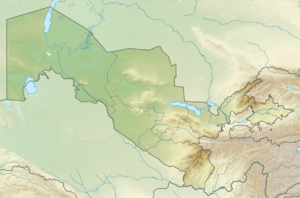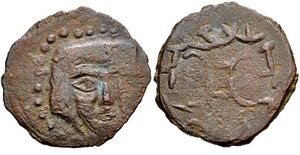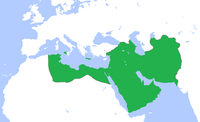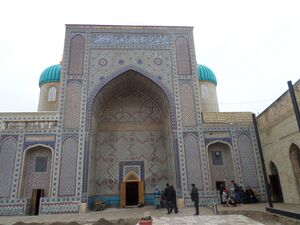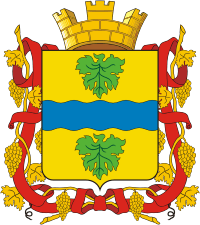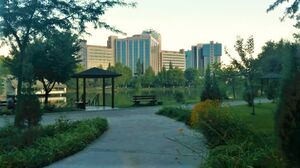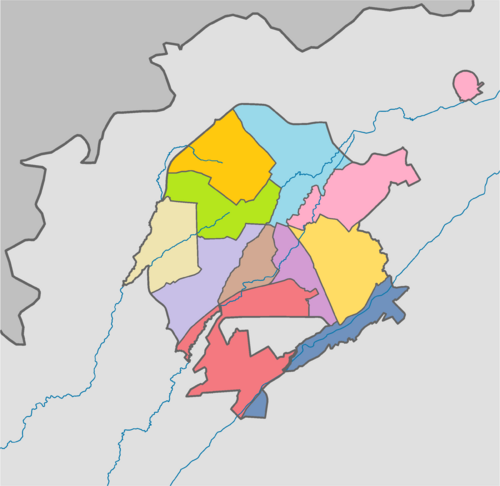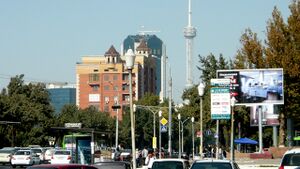طشقند
طشقند
اوزبكية: Тошкент / Toshkent Tаshkent | |
|---|---|
مع عقارب الساعة من أعلى: Skyline of Tashkent, Hilton Tashkent City, Humo Ice Dome, Amir Timur Museum, Tashkent Supreme Assembly Building, Cathedral of the Assumption of the Virgin، طشقند في الليل. | |
| الكنية: Tash (A rock) | |
| الشعار: Kuch Adolatdadir! ("Strength is in Justice!") | |
| الإحداثيات: 41°18′N 69°16′E / 41.300°N 69.267°ECoordinates: 41°18′N 69°16′E / 41.300°N 69.267°E | |
| البلد | |
| Settled | 5th to 3rd centuries BC |
| الحكومة | |
| • النوع | City Administration |
| • Hakim (Mayor) | Jahongir Ortiqxo'jaev |
| المساحة | |
| • الإجمالي | 334٫8 كم² (129٫3 ميل²) |
| المنسوب | 455 m (1٬493 ft) |
| التعداد (15 April 2022)[1] | |
| • الإجمالي | 2٬750٬000 |
| • الكثافة | 8٬200/km2 (21٬000/sq mi) |
| منطقة التوقيت | UTC+5 ( ) |
| مفتاح الهاتف | 71 |
| HDI (2019) | 0.809[2] very high |
| الموقع الإلكتروني | tashkent |
طشقند ( /tæʃˈkɛnt/, /USalsotɑːʃʔ/) (من روسية: Ташкент), أو Toshkent ( /tɒʃˈkɛnt/؛ اوزبكية: Тошкент, Toshkent/تاشکند, IPA: [tɒʃˈkent]), كما عُرفت تاريخياً بإسم چاچ ( Chach ؛ فارسية: چاچ)، هي عاصمة ولاية طشقند، وعاصمة أوزبكستان، وكانت محطة على طريق الحرير. في عام 2021 وصل عدد سكانها إلى 2,694,400 مليون نسمة.[1] وتقع في شمال شرق أوزبكستان، بالقرب من الحدود مع قزخستان.
Before Islamic influence started in the mid 8th century AD, Tashkent was influenced by the Sogdian and Turkic cultures. After Genghis Khan destroyed it in 1219, it was rebuilt and profited from the Silk Road. From the 18th to the 19th century, the city became an independent city-state, before being re-conquered by the Khanate of Kokand. In 1865, Tashkent fell to the Russian Empire; it became the capital of Russian Turkestan. In Soviet times, it witnessed major growth and demographic changes due to forced deportations from throughout the Soviet Union. Much of Tashkent was destroyed in the 1966 Tashkent earthquake, but it was rebuilt as a model Soviet city. It was the fourth-largest city in the Soviet Union at the time, after Moscow, Leningrad and Kyiv.[3]
Today, as the capital of an independent Uzbekistan, Tashkent retains a multiethnic population, with ethnic Uzbeks as the majority. In 2009, it celebrated its 2,200 years of written history.[4]
. . . . . . . . . . . . . . . . . . . . . . . . . . . . . . . . . . . . . . . . . . . . . . . . . . . . . . . . . . . . . . . . . . . . . . . . . . . . . . . . . . . . . . . . . . . . . . . . . . . . . . . . . . . . . . . . . . . . . . . . . . . . . . . . . . . . . . . . . . . . . . . . . . . . . . . . . . . . . . . . . . . . . . . .
التاريخ
التسمية
كلمة طشقند اسم مركب من كلمتين طاش بمعنى الحجر وكنت بمعنى مدينة. During its long history, Tashkent has had various changes in names and political and religious affiliations. Abu Rayhan Biruni wrote that the city's name Tashkent comes from the Turkic tash and kent, literally translated as "Stone City" or "City of Stones".[5] Ilya Gershevitch (1974:55, 72) (apud Livshits, 2007:179) traces the city's old name Chach back to Old Iranian *čāiča- "area of water, lake" (cf. Lake Čaēčista mentioned in the Avesta) (whence Middle Chinese transcription *źiäk > standard Chinese Shí with Chinese character 石 for "stone"[6][7]), and *Čačkand ~ Čačkanθ was the basis for Turkic adaption Tashkent, popularly etymologized as "stone city".[8]
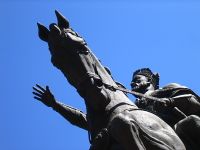
فتح العرب المسلمون المدينة في القرن الثامن الميلادي، وقد استولى عليها جنكيز خان في القرن الثالث عشر الميلادي، ثم تيمورلنك عام 1361.[9]
التاريخ المبكر
Tashkent was first settled some time between the 5th and 3rd centuries BC by ancient people as an oasis on the Chirchik River, near the foothills of the West Tian Shan Mountains. In ancient times, this area contained Beitian, probably the summer "capital" of the Kangju confederacy.[10] Some scholars believe that a "Stone Tower" mentioned by Ptolemy in his famous treatise Geography, and by other early accounts of travel on the old Silk Road, referred to this settlement (due to its etymology). This tower is said to have marked the midway point between Europe and China. Other scholars, however, disagree with this identification, though it remains one of four most probable sites for the Stone Tower.[11][12]
التاريخ كـ چاچ
In pre-Islamic and early Islamic times, the town and the province were known as Chach. شاهنامة الفردوسي تشير أيضاً إلى المدينة كـ چاچ.
The principality of Chach had a square citadel built around the 5th to 3rd centuries BC, some 8 kilometres (5.0 mi) south of the Syr Darya River. By the 7th century AD, Chach had more than 30 towns and a network of over 50 canals, forming a trade center between the Sogdians and Turkic nomads. The Buddhist monk Xuanzang (602/603? – 664 AD), who travelled from China to India through Central Asia, mentioned the name of the city as Zhěshí (赭時). The Chinese chronicles History of Northern Dynasties, Book of Sui, and Old Book of Tang mention a possession called Shí 石 ("stone") or Zhěshí 赭時 with a capital of the same name since the fifth century AD.[15]
In 558–603, Chach was part of the Turkic Kaganate. At the beginning of the 7th century, the Turkic Kaganate, as a result of internecine wars and wars with its neighbors, disintegrated into the Western and Eastern Kaganates. The Western Turkic ruler Tong Yabghu Qaghan (618-630) set up his headquarters in the Ming-bulak area to the north of Chach. Here he received embassies from the emperors of the Tang Empire and Byzantium.[16] In 626, the Indian preacher Prabhakaramitra arrived with ten companions to the kagan. In 628, a Buddhist Chinese monk Xuanzang arrived in Ming Bulak.
The Turkic rulers of Chach minted their coins with the inscription on the obverse side of the "lord of the Khakan money" (mid-8th century); with an inscription in the ruler Turk (VII century), in Nudjket in the middle of the VIII century, coins were issued with the obverse inscription “Nanchu (Banchu) Ertegin sovereign".[17]
الخلافة الإسلامية
Tashkent was conquered by the Arabs at the beginning of the 8th century.[18]
According to the descriptions of the authors of the 10th century, Shash was structurally divided into a citadel, an inner city (madina) and two suburbs - an inner (rabad-dahil) and an outer (rabad-harij). The citadel, surrounded by a special wall with two gates, contained the ruler's palace and the prison.[19]
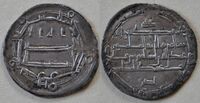
حكم ما بعد الخلافة
Under the Samanid Empire, whose founder Ismail Samani was a descendant of Persian Zoroastrian convert to Islam, the city came to be known as Binkath. However, the Arabs retained the old name of Chach for the surrounding region, pronouncing it ash-Shāsh (الشاش) instead. Kand, qand, kent, kad, kath, kud—all meaning a city—are derived from the Persian/Sogdian کنده (kanda), meaning a town or a city. They are found in city names such as Samarkand, Yarkand, Panjakent, Khujand etc.). Abu Bakr Muhammad ibn Ali ash-Shashi, known as al-Kaffal ash-Shashi (904-975), was born in Tashkent - an Islamic theologian, scholar, jurist of the Shafi'i madhhab, hadith scholar and linguist.[بحاجة لمصدر]
After the 11th century, the name evolved from Chachkand/Chashkand to Tashkand. The modern spelling of "Tashkent" reflects Russian orthography and 20th-century Soviet influence.
At the end of the 10th century, Tashkent became part of the possessions of the Turkic state of the Karakhanids. In 998/99 the Tashkent oasis went to the Karakhanid Ahmad ibn Ali, who ruled the north-eastern regions of Mavarannahr. In 1177/78, a separate khanate was formed in the Tashkent oasis. Its center was Banakat, where dirhams Mu'izz ad-dunya wa-d-din Qilich-khan were minted, in 1195-1197 - Jalal ad-dunya wa-d-din Tafgach-khakan, in 1197-1206 - 'Imad ad-dunya va-d-din Ulug Egdish Chagry-khan.[20]
الفتح المنغولي
The city was destroyed by Genghis Khan in 1219 and lost much of its population as a result of the Mongols' destruction of the Khwarezmid Empire in 1220.
. . . . . . . . . . . . . . . . . . . . . . . . . . . . . . . . . . . . . . . . . . . . . . . . . . . . . . . . . . . . . . . . . . . . . . . . . . . . . . . . . . . . . . . . . . . . . . . . . . . . . . . . . . . . . . . . . . . . . . . . . . . . . . . . . . . . . . . . . . . . . . . . . . . . . . . . . . . . . . . . . . . . . . . .
الفترة التيمورية
Under the Timurid and subsequent Shaybanid dynasties, the city's population and culture gradually revived as a prominent strategic center of scholarship, commerce and trade along the Silk Road. During the reign of Amir Timur (1336-1405), Tashkent was restored and in the 14th-15th centuries Tashkent was part of Timur's empire. For Timur, Tashkent was considered a strategic city. In 1391 Timur set out in the spring from Tashkent to Desht-i-Kipchak to fight the Khan of the Golden Horde Tokhtamysh Khan. Timur returned from this victorious campaign through Tashkent.[21]
The most famous saint Sufi of Tashkent was Sheikh Khovendi at-Takhur (13th to the first half of the 14th century). According to legend, Amir Timur, who was treating his wounded leg in Tashkent with the healing water of the Zem-Zem spring, ordered to build a mausoleum for the saint. By order of Timur, the Zangiata mausoleum was built.
فترة الأسرة الشيبانية الأوزبكية
In the 16th century, Tashkent was ruled by the Shaybanid dynasty.[22][23]
Shaybanid Suyunchkhoja Khan was an enlightened Uzbek ruler; following the traditions of his ancestors Mirzo Ulugbek and Abul Khair Khan, he gathered famous scientists, writers and poets at his court, among them: Vasifi, Abdullah Nasrullahi, Masud bin Osmani Kuhistani. Since 1518 Vasifi was the educator of the son of Suyunchhoja Khan Keldi Muhammad, with whom, after the death of his father in 1525, he moved to Tashkent. After the death of his former pupil, he became the educator of his son, Abu-l-Muzaffar Hasan-Sultan.[24]
Later the city was subordinated to Shaybanid Abdullah Khan II (the ruler actually from 1557, officially in 1583–1598), who issued his coins here[25] From 1598 to 1604 Tashkent was ruled by the Shaybanid Keldi Muhammad, who issued silver and copper coins on his behalf.[26]
القرن 17 إلى النصف الأول من القرن 18
In 1598, Kazakh Taukeel Khan was at war with the Khanate of Bukhara. The Bukhara troops sent against him were defeated by Kazakhs in the battle between Tashkent and Samarkand. During the reign of Yesim-Khan,[27] a peace treaty was concluded between Bukhara and Kazakhs, according to which Kazakhs abandoned Samarkand, but left behind Tashkent, Turkestan and a number of Syr Darya cities.
Yesim-Khan ruled the Kazakh Khanate from 1598 to 1628, his main merit was that he managed to unite the Kazakh khanate.
دولة طشقند
In 1784, Yunus Khoja, the ruler of the dakha (district) Shayhantahur, united the entire city under his rule and created an independent Tashkent state (1784-1807), which by the beginning of the 19th century seized vast lands.[28]
خانية قوقند
In 1809, Tashkent was annexed to the Khanate of Kokand.[29] At the time, Tashkent had a population of around 100,000 and was considered the richest city in Central Asia.
Under the Kokand domination, Tashkent was surrounded by a moat and an adobe battlement (about 20 kilometers long) with 12 gates.[30]
It prospered greatly through trade with Russia but chafed under Kokand's high taxes. The Tashkent clergy also favored the clergy of Bukhara over that of Kokand. However, before the Emir of Bukhara could capitalize on this discontent, the Russian army arrived.
فترة الاحتلال الروسي
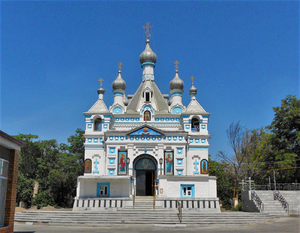
In May 1865, Mikhail Grigorevich Chernyayev (Cherniaev), acting against the direct orders of the tsar and outnumbered at least 15–1, staged a daring night attack against a city with a wall 25 kilometres (16 mi) long with 11 gates and 30,000 defenders. While a small contingent staged a diversionary attack, the main force penetrated the walls, led by a Russian Orthodox priest. Although the defense was stiff, the Russians captured the city after two days of heavy fighting and the loss of only 25 dead as opposed to several thousand of the defenders (including Alimqul, the ruler of the Kokand Khanate). Chernyayev, dubbed the "Lion of Tashkent" by city elders, staged a "hearts-and-minds" campaign to win the population over. He abolished taxes for a year, rode unarmed through the streets and bazaars meeting common people, and appointed himself "Military Governor of Tashkent", recommending to Tsar Alexander II that the city become an independent khanate under Russian protection.
The Tsar liberally rewarded Chernyayev and his men with medals and bonuses, but regarded the impulsive general as a "loose cannon", and soon replaced him with General Konstantin Petrovich von Kaufman. Far from being granted independence, Tashkent became the capital of the new territory of Russian Turkistan, with Kaufman as first Governor-General. A cantonment and Russian settlement were built across the Ankhor Canal from the old city, and Russian settlers and merchants poured in. Tashkent was a center of espionage in the Great Game rivalry between Russia and the United Kingdom over Central Asia. The Turkestan Military District was established as part of the military reforms of 1874. The Trans-Caspian Railway arrived in 1889, and the railway workers who built it settled in Tashkent as well, bringing with them the seeds of Bolshevik Revolution.
تأثير الثورة الروسية
With the fall of the Russian Empire, the Russian Provisional Government removed all civil restrictions based on religion and nationality, contributing to local enthusiasm for the February Revolution. The Tashkent Soviet of Soldiers' and Workers' Deputies was soon set up, but primarily represented Russian residents, who made up about a fifth of the Tashkent population. Muslim leaders quickly set up the Tashkent Muslim Council (Tashkand Shura-yi-Islamiya) based in the old city. On 10 March 1917, there was a parade with Russian workers marching with red flags, Russian soldiers singing La Marseillaise and thousands of local Central Asians. Following various speeches, Governor-General Aleksey Kuropatkin closed the events with words "Long Live a great free Russia".[31]
The First Turkestan Muslim Conference was held in Tashkent 16–20 April 1917. Like the Muslim Council, it was dominated by the Jadid, Muslim reformers. A more conservative faction emerged in Tashkent centered around the Ulema. This faction proved more successful during the local elections of July 1917. They formed an alliance with Russian conservatives, while the Soviet became more radical. The Soviet attempt to seize power in September 1917 proved unsuccessful.[32]
In April 1918, Tashkent became the capital of the Turkestan Autonomous Soviet Socialist Republic (Turkestan ASSR). The new regime was threatened by White forces, basmachi; revolts from within, and purges ordered from Moscow.
. . . . . . . . . . . . . . . . . . . . . . . . . . . . . . . . . . . . . . . . . . . . . . . . . . . . . . . . . . . . . . . . . . . . . . . . . . . . . . . . . . . . . . . . . . . . . . . . . . . . . . . . . . . . . . . . . . . . . . . . . . . . . . . . . . . . . . . . . . . . . . . . . . . . . . . . . . . . . . . . . . . . . . . .
الفترة السوڤيتية
The city began to industrialize in the 1920s and 1930s.
Violating the Molotov–Ribbentrop Pact, Nazi Germany invaded the Soviet Union in June 1941. The government worked to relocate factories from western Russia and Ukraine to Tashkent to preserve the Soviet industrial capacity. This led to great increase in industry during World War II.
It also evacuated most of the German communist emigres to Tashkent.[33] The Russian population increased dramatically; evacuees from the war zones increased the total population of Tashkent to well over a million. Russians and Ukrainians eventually comprised more than half of the total residents of Tashkent.[34] Many of the former refugees stayed in Tashkent to live after the war, rather than return to former homes.
During the postwar period, the Soviet Union established numerous scientific and engineering facilities in Tashkent.
On 10 January 1966, then Indian Prime Minister Lal Bahadur Shastri and Pakistan President Ayub Khan signed a pact in Tashkent with Soviet Premier Alexei Kosygin as the mediator to resolve the terms of peace after the Indo-Pakistani War of 1965. On the next day, Shastri died suddenly, reportedly due to a heart attack. It is widely speculated that Shastri was killed by poisoning the water he drank.[بحاجة لمصدر]
Much of Tashkent's old city was destroyed by a powerful earthquake on 26 April 1966. More than 300,000 residents were left homeless, and some 78,000 poorly engineered homes were destroyed,[35] mainly in the densely populated areas of the old city where traditional adobe housing predominated.[36] The Soviet republics, and some other countries, such as Finland, sent "battalions of fraternal peoples" and urban planners to help rebuild devastated Tashkent.
Tashkent was rebuilt as a model Soviet city with wide streets planted with shade trees, parks, immense plazas for parades, fountains, monuments, and acres of apartment blocks. The Tashkent Metro was also built during this time. About 100,000 new homes were built by 1970,[35] but the builders occupied many, rather than the homeless residents of Tashkent.[بحاجة لمصدر] Further development in the following years increased the size of the city with major new developments in the Chilonzor area, north-east and south-east of the city.[35]
At the time of the collapse of the Soviet Union in 1991, Tashkent was the fourth-largest city in the USSR and a center of learning in the fields of science and engineering.
Due to the 1966 earthquake and the Soviet redevelopment, little architectural heritage has survived of Tashkent's ancient history. Few structures mark its significance as a trading point on the historic Silk Road.
عاصمة أوزبكستان
مع سقوط الإمبراطورية الروسية القيصرية في أبريل 1918، اصبحت طشقند عاصمة جمهورية تركستان المستقلة ذاتيا السوفيتية الإشتراكية. تحت ضغط القوات البيضاء والجواسيس البريطانيين و ثورة بسمتچي انهارت جمهورية تركستان، ولتصبح طشقند مدينة ضمن الجمهورية الأوزبكية حتى عام 1930 عندما حلت محل سمرقند كعاصمة للجمهورية الأوزبكية. وفي 25 أبريل 1966 دمر طشقند زلزال عنيف (7.5 على مقياس رختر) شرد 300,000 من سكانها.
Since 1991, the city has changed economically, culturally, and architecturally. New development has superseded or replaced icons of the Soviet era. The largest statue ever erected for Lenin was replaced with a globe, featuring a geographic map of Uzbekistan. Buildings from the Soviet era have been replaced with new modern buildings. The "Downtown Tashkent" district includes the 22-story NBU Bank building, international hotels, the International Business Center, and the Plaza Building.
The Tashkent Business district is a special district, established for the development of small, medium and large businesses in Uzbekistan. In 2018, was started to build a Tashkent city (new Downtown) which would include a new business district with skyscrapers of local and foreign companies, world hotels such as Hilton Tashkent Hotel, apartments, biggest malls, shops and other entertainments. The construction of the International Business Center is planned to be completed by the end of 2021. [37] Fitch assigns “BB-” rating to Tashkent city, “Stable” forecast. [38]
In 2007, Tashkent was named a "cultural capital of the Islamic world" by Moscow News, as the city has numerous historic mosques and significant Islamic sites, including the Islamic University.[39] Tashkent holds the Samarkand Kufic Quran, one of the earliest written copies of the Quran, which has been located in the city since 1924.[40]
Tashkent is the most visited city in the country,[41] and has greatly benefited from increasing tourism as a result of reforms under president Shavkat Mirziyoyev and opening up by abolishing visas for visitors from the European Union and other developing countries or making visas easier for foreigners.[42]
طشقند على مر السنين
- Development of Tashkent
1966: earthquake and subsequent redevelopment
المدينة وأصل التلفزيون
The first demonstration of a fully electronic TV set to the public was made in Tashkent in summer 1928 by Boris Grabovsky and his team. In his method that had been patented in Saratov in 1925, Boris Grabovsky proposed a new principle of TV imaging based on the vertical and horizontal electron beam sweeping under high voltage. Nowadays this principle of the TV imaging is used practically in all modern cathode-ray tubes. Historian and ethnographer Boris Golender (Борис Голендер in Russian), in a video lecture, described this event.[43] This date of demonstration of the fully electronic TV set is the earliest known so far. Despite this fact, most modern historians disputably consider Vladimir Zworykin and Philo Farnsworth[44] as inventors of the first fully electronic TV set. In 1964, the contribution made to the development of early television by Grabovsky was officially acknowledged by the Uzbek government and he was awarded the prestigious degree "Honorable Inventor of the Uzbek Soviet Socialist Republic".
الجغرافيا
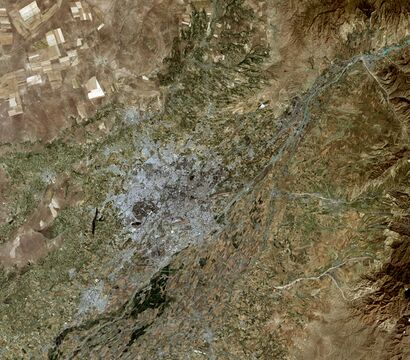
| طشقند | ||||||||||||||||||||||||||||||||||||||||||||||||||||||||||||
|---|---|---|---|---|---|---|---|---|---|---|---|---|---|---|---|---|---|---|---|---|---|---|---|---|---|---|---|---|---|---|---|---|---|---|---|---|---|---|---|---|---|---|---|---|---|---|---|---|---|---|---|---|---|---|---|---|---|---|---|---|
| جدول طقس (التفسير) | ||||||||||||||||||||||||||||||||||||||||||||||||||||||||||||
| ||||||||||||||||||||||||||||||||||||||||||||||||||||||||||||
| ||||||||||||||||||||||||||||||||||||||||||||||||||||||||||||
الموقع
تقع طشقند بين نهري سيحون وجيحون. وتظهر وديان وسهول وجبال أوزبكستان وكأنها أرض انبثقت من بين أصابع الماء. وأوزبكستان تقع جغرافيًا في المنطقة التى عرفت قديمًا باسم التركستان، وهواسم يتكون من مقطعين ترك وهم الأتراك، وستان وهى كلمة فارسية بمعنى مدينة.
المناخ
| بيانات مناخ طشقند | |||||||||||||
|---|---|---|---|---|---|---|---|---|---|---|---|---|---|
| الشهر | يناير | فبراير | مارس | أبريل | مايو | يونيو | يوليو | أغسطس | سبتمبر | اكتوبر | نوفمبر | ديسمبر | العام |
| العظمى المتوسطة °س (°ف) | 5.8 (42.4) |
7.9 (46.2) |
14.3 (57.7) |
21.8 (71.2) |
27.4 (81.3) |
33.2 (91.8) |
35.7 (96.3) |
34.0 (93.2) |
28.7 (83.7) |
21.0 (69.8) |
14.2 (57.6) |
8.5 (47.3) |
21٫04 (69٫88) |
| الصغرى المتوسطة °س (°ف) | -3.1 (26.4) |
-1.5 (29.3) |
4.2 (39.6) |
9.9 (49.8) |
13.7 (56.7) |
17.7 (63.9) |
19.4 (66.9) |
17.2 (63) |
12.4 (54.3) |
7.2 (45) |
3.3 (37.9) |
-0.3 (31.5) |
8٫34 (47٫02) |
| هطول mm (inches) | 54.5 (2.146) |
46.8 (1.843) |
72.3 (2.846) |
63.6 (2.504) |
32.0 (1.26) |
7.1 (0.28) |
3.5 (0.138) |
2.0 (0.079) |
4.5 (0.177) |
34.1 (1.343) |
45.0 (1.772) |
53.4 (2.102) |
418٫8 (16٫488) |
| Avg. precipitation days | 13.7 | 12.3 | 13.8 | 12.9 | 10.2 | 5.1 | 2.9 | 1.9 | 3.2 | 8.1 | 10.2 | 12.8 | 107٫1 |
| Sunshine hours | 124.0 | 112.0 | 155.0 | 240.0 | 310.0 | 360.0 | 403.0 | 372.0 | 300.0 | 248.0 | 150.0 | 124.0 | 2٬898 |
| Source #1: World Meteorological Organisation (UN)[45] | |||||||||||||
| Source #2: Hong Kong Observatory[46] | |||||||||||||
السكان
In 1983, the population of Tashkent amounted to 1,902,000 people living in a municipal area of 256 km2 (99 sq mi). By 1991, (Dissolution of the Soviet Union) the number of permanent residents of the capital had grown to approximately 2,136,600. Tashkent was the fourth most populated city in the former USSR, after Moscow, Leningrad (St. Petersburg), and Kyiv. Nowadays, Tashkent remains the fourth most populous city in the CIS. The population of the city was 2,716,176 people in 2020.[47]
اعتبارا من 2008[تحديث], the demographic structure of Tashkent was as follows:
- 63.0% – Uzbeks
- 20.0% – Russians
- 4.5% – Tatars
- 2.2% – Koryo-saram (Koreans)
- 2.1% – Tajiks
- 1.2% – Uighurs
- 7.0% – other ethnic backgrounds
| التعداد التاريخي | |||||||||||||||||||||||||||||||||||||||||||||||||||||||||||||||||||||||||||||||||||||||||||||||||
|---|---|---|---|---|---|---|---|---|---|---|---|---|---|---|---|---|---|---|---|---|---|---|---|---|---|---|---|---|---|---|---|---|---|---|---|---|---|---|---|---|---|---|---|---|---|---|---|---|---|---|---|---|---|---|---|---|---|---|---|---|---|---|---|---|---|---|---|---|---|---|---|---|---|---|---|---|---|---|---|---|---|---|---|---|---|---|---|---|---|---|---|---|---|---|---|---|---|
|
| ||||||||||||||||||||||||||||||||||||||||||||||||||||||||||||||||||||||||||||||||||||||||||||||||
| المصدر: Uzbekistan State Statistics Committee[48][49] and Demoscope.ru[50][51][52][53][54] | |||||||||||||||||||||||||||||||||||||||||||||||||||||||||||||||||||||||||||||||||||||||||||||||||
Uzbek is the main spoken language as well as Russian for inter-ethnic communication. As with most of Uzbekistan, street signs and other things are often a mix of Latin and Cyrillic scripts.[55][56]
الأحياء
Since 2020, when the Yangihayot district was created,[57] Tashkent is divided into the following 12 districts (اوزبكية: tumanlar):
| Nr | District | Population (2021)[1] |
Area (km2)[58][57] |
Density (area/km2) |
Map |
|---|---|---|---|---|---|
| 1 | Bektemir | 31,400 | 17.83 | 1٬761 | 
|
| 2 | Chilanzar | 260,700 | 29.94 | 8٬707 | 
|
| 3 | Yashnobod | 258,800 | 33.7 | 7٬680 | 
|
| 4 | Mirobod | 142,800 | 17.1 | 8٬351 | 
|
| 5 | Mirzo Ulugbek | 285,000 | 35.15 | 8٬108 | 
|
| 6 | Sergeli | 105,700 | 37.36 | 2٬829 | 
|
| 7 | Shayxontoxur | 348,300 | 29.7 | 11٬727 | 
|
| 8 | Olmazor | 377,100 | 34.5 | 10٬930 | 
|
| 9 | Uchtepa | 278,200 | 24 | 11٬592 | 
|
| 10 | Yakkasaray | 121,600 | 14.6 | 8٬329 | 
|
| 11 | Yunusabad | 352,000 | 40.6 | 8٬670 | 
|
| 12 | Yangihayot | 132,800 | 44.20 | 3٬005 |
At the time of the Tsarist take over it had four districts (Uzbek daha):
- Beshyoghoch
- Kukcha
- Shaykhontokhur
- Sebzor
In 1940 it had the following districts (Russian район):
By 1981 they were reorganized into:[35]
- Bektemir
- Akmal-Ikramov (Uchtepa)
- Khamza (Yashnobod)
- Lenin (Mirobod)
- Kuybishev (Mirzo Ulugbek)
- Sergeli
- Oktober (Shaykhontokhur)
- Sobir Rakhimov (Olmazar)
- Chilanzar
- Frunze (Yakkasaray)
- Kirov (Yunusabad)
معرض صور
المعالم الرئيسية
- مدرسة سيونج خان، سلطان "طشقند"، وتعرف أيضا باسم "براق خان" الذى أعلن إسلامه قُبيل وفاته بأيام قليلة في سنة (1270 م) واتخذ لنفسه اسم "غياث الدين" وقد تعرضت هذه المدرسة للتصدع، بسبب الزلازل التى ضربت المدينة.
- مدرسة كوكلتاش ؛ التى يرجع تاريخها إلى القرن (16 م).
- جامع تلاخان، ويسمى أيضًا "جامع الشيخ طلعت" الذى يُعدُّ المسجد الجامع للمدينة.
- ومن أبرز علماء "طشقند" أبوبكر محمد بن على بن على بن إسماعيل، وكان عالمًا في التفسير واللغة، وتوفى سنة (366هـ).
التعليم
الإعلام
الاقتصاد
بالمدينة بعض المنشآت الصناعية، ومصانع لنسج القطن. وهي المركز الإقليمي لإنتاج المنسوجات القطنية.
النقل
لطشقند اتصالات مع كرانوفودسك عن طريق السكك الحديدية كما تتصل بخطوط السكك الحديدية مع سيبريا.
الرياضة
مدن شقيقة
 Almaty، كزاخستان
Almaty، كزاخستان أنقرة، تركيا
أنقرة، تركيا أستنا، كزاخستان
أستنا، كزاخستان بكين، الصين
بكين، الصين برلين، ألمانيا
برلين، ألمانيا بيشكك، قيرغيزستان
بيشكك، قيرغيزستان القاهرة، مصر
القاهرة، مصر Dnipropetrovsk، اوكرانيا
Dnipropetrovsk، اوكرانيا إسطنبول، تركيا
إسطنبول، تركيا كراشي، پاكستان
كراشي، پاكستان كيڤ، اوكرانيا
كيڤ، اوكرانيا Kortrijk، بلجيكا
Kortrijk، بلجيكا موسكو، روسيا
موسكو، روسيا Riga، لاتڤيا
Riga، لاتڤيا سياتل، الولايات المتحدة
سياتل، الولايات المتحدة Skopje، مقدونيا
Skopje، مقدونيا تونس العاصمة، تونس
تونس العاصمة، تونس سول، كوريا الجنوبية
سول، كوريا الجنوبية
انظر أيضا
المصادر
- ^ أ ب ت "Urban and rural population by district" (PDF) (in الأوزبكية). Tashkent City department of statistics.
- ^ "Sub-national HDI – Area Database – Global Data Lab". hdi.globaldatalab.org (in الإنجليزية). Retrieved 13 سبتمبر 2018.
- ^ Praying Through the 100 Gateway Cities of the 10/40 Window ISBN 978-0-927-54580-8 p. 89
- ^ "Юбилей Ташкента. Такое бывает только раз в 2200 лет". Фергана – международное агентство новостей. Retrieved 10 ديسمبر 2017.
- ^ Sachau, Edward C. Alberuni’s India: an Account of the Religion. Philosophy, Literature, Geography, Chronology, Astronomy, Customs, Laws and Astrology of India about AD 1030, vol. 1 London: KEGAN PAUL, TRENCH, TRtJBNBR & CO. 1910. p.298.
- ^ قالب:Iranica
- ^ قالب:Iranica
- ^ Livshits, Vladimir (2007). "The Leader of the People of Chach in Sogdian Inscriptions" in Macuch, Maggi, & Sundermann (eds.) Iranian Languages and Texts from Iran and Turan. Ronald E. Emmerick Memorial Volume. p. 179
- ^ طشقند، الموسوعة العربية
- ^ Pulleyblank, Edwin G. "The Consonantal System of Old Chinese," Asia Major 9 (1963), p. 94.
- ^ Dean, Riaz (2022). The Stone Tower: Ptolemy, the Silk Road, and a 2,000-Year-Old Riddle (in English). Delhi: Penguin Viking. pp. 134 (Map 4), 170. ISBN 978-0670093625.
{{cite book}}: CS1 maint: unrecognized language (link) - ^ Dean, Riaz (2015). "The Location of Ptolemy's Stone Tower: the Case for Sulaiman-Too in Osh". The Silk Road. 13: 76.
- ^ Baumer, Christoph (18 أبريل 2018). History of Central Asia, The: 4-volume set (in الإنجليزية). Bloomsbury Publishing. p. 243. ISBN 978-1-83860-868-2.
- ^ Whitfield, Susan (2004). The Silk Road: Trade, Travel, War and Faith (in الإنجليزية). British Library. Serindia Publications, Inc. p. 110. ISBN 978-1-932476-13-2.
- ^ Bichurin, 1950. v. II
- ^ Golden, P.B. An Introduction to the History of the Turkic Peoples. Series: Turcologica. Wiesbaden: Otto-Harrassowitz. 1992
- ^ Baratova L. S. Drevnetyurkskiye monety Sredney Azii VI—IKH vv. (tipologiya, ikonografiya, istoricheskaya interpretatsiya). Avtoreferat diss. kand. ist. nauk. — T., 1995, s.12
- ^ O. G. Bol'shakov. Istoriya Khalifata, t. 4: apogey i padeniye. — Moskva: «Vostochnaya literatura» RAN, 2010
- ^ Filanovich, M.I. Tashkent (zarozhdeniye i razvitiye goroda i gorodskoy kul'tury). Tashkent, 1983, p.188
- ^ Kochnev B. D., Numizmaticheskaya istoriya Karakhanidskogo kaganata (991—1209 gg.). Moskva «Sofiya», 2006, p.157,234
- ^ Fasikh Akhmad ibn Dzhalal ad-Din Mukhammad al-Khavafi. Fasikhov svod. Tashkent: Fan. 1980, p.114
- ^ Dobromyslov A. I., Tashkent v proshlom i nastoyashchem. Tashkent, 1912, p.9
- ^ Istoriya Tashkenta. Tashkent: Fan, 1988, p.70
- ^ Yudin V. P. Materialy po istorii kazakhskikh khanstv XV-XVIII vekov. (Izvlecheniya iz persidskikh i tyurkskikh sochineniy). — Alma-Ata : Nauka, 1969, p.174.
- ^ Ye. A. Davidovich, Korpus zolotykh i serebryanykh monet Sheybanidov. XVI vek. M., 1992
- ^ Burnasheva R. Z., Nekotoryye svedeniya o chekanke mednykh monet v Tashkente v XVI—XIX vv. Izvestiya Natsional'noy akademii nauk Kazakhstana, № 1, 2007, p.153
- ^ "Yesim-Khan". www.researchgate.net.
- ^ Istoriya Tashkenta (s drevneyshikh vremon do pobedy Fevral'skoy burzhuazno-demokraticheskoy revolyutsii) / Ziyayev KH. Z., Buryakov YU. V. Tashkent: «Fan», 1988
- ^ Planet, Lonely. "History in Tashkent, Uzbekistan".
- ^ Istoriya Tashkenta (s drevneyshikh vremyon do pobedy Fevralskoy burzhuazno-demokraticheskoy revolyutsii) / Ziyayev Kh. Z., Buryakov Y.F. Tashkent: «Fan», 1988
- ^ Jeff Sahadeo, Russian Colonial Society in Tashkent, Indiana University Press, 2007, p188
- ^ Rex A. Wade, The Russian Revolution, 1917, Cambridge University Press, 2005
- ^ Robert K. Shirer, "Johannes R. Becher 1891–1958", Encyclopedia of German Literature, Chicago and London: Fitzroy Dearborn Publishers, 2000, by permission at Digital Commons, University of Nebraska, accessed 3 February 2013
- ^ Edward Allworth (1994), Central Asia, 130 Years of Russian Dominance: A Historical Overview, Duke University Press, p. 102. ISBN 0-8223-1521-1
- ^ أ ب ت ث Sadikov, A C; Akramob Z. M.; Bazarbaev, A.; Mirzlaev T.M.; Adilov S. R.; Baimukhamedov X. N.; et al. (1984). Geographical Atlas of Tashkent (Ташкент Географический Атлас) (in الروسية) (2 ed.). Moscow. pp. 60, 64.
{{cite book}}: CS1 maint: location missing publisher (link) - ^ Nurtaev Bakhtiar (1998). "Damage for buildings of different type". Institute of Geology and Geophysics, Academy of Sciences of Uzbekistan. Retrieved 7 نوفمبر 2008.
- ^ "Archived copy". Archived from the original on 21 ديسمبر 2019. Retrieved 4 مايو 2020.
{{cite web}}: CS1 maint: archived copy as title (link) - ^ https://www.fitchratings.com/research/ru/international-public-finance/fitch-prisvoilo-gorodu-tashkentu-rejting-bb-prognoz-stabil-nyj-17-06-2019 قالب:Bare URL inline
- ^ "Moscow News – World – Tashkent Touts Islamic University". Mnweekly.ru. 21 يونيو 2007. Archived from the original on 15 أبريل 2008. Retrieved 6 مايو 2009.
- ^ "Tashkent's hidden Islamic relic". BBC. 5 يناير 2006. Retrieved 16 أبريل 2011.
- ^ "Uzbekistan doubles the number of tourists in 2018". Brussels Express. 23 نوفمبر 2018. Retrieved 30 أكتوبر 2019.
- ^ "Uzbekistan announces ambition to become major tourist destination". Euractiv. 19 نوفمبر 2018. Retrieved 30 أكتوبر 2019.
- ^ "Видеолекторий "Ферганы": Изобретение телевидения и Борис Грабовский". Фергана.Ру.
- ^ K. Krull, The boy who invented TV: The story of Philo Farnsworth, 2014
- ^ أ ب "World Weather Information Service – Tashkent". World Meteorological Organisation. Retrieved 13 أبريل 2010.
- ^ {{cite web | url = http://www.hko.gov.hk/wxinfo/climat/world/eng/asia/westasia/tashkent_e.htm | title = Climatological Normals of Tashkent | accessdate = 2010-06-06 | publisher = Hong Kong Observatory |date=August 2010
- ^ "ТАШКЕНТ (город)". Dic.academic.ru. Retrieved 24 نوفمبر 2013.
- ^ "Hududlar boʻyicha shahar va qishloq aholisi soni (2010–2021-yillar)" (in الأوزبكية). Uzbekistan State Statistics Committee. 16 يوليو 2021. Retrieved 16 يوليو 2021.
- ^ "Постоянное среднее число населения" (in الروسية). Uzbekistan State Statistics Committee. 27 سبتمبر 2013. Archived from the original on 21 أكتوبر 2013. Retrieved 10 أبريل 2014.
- ^ "Демоскоп Weekly - Приложение. Справочник статистических показателей". www.demoscope.ru.
- ^ "Демоскоп Weekly - Приложение. Справочник статистических показателей". www.demoscope.ru.
- ^ "Демоскоп Weekly - Приложение. Справочник статистических показателей". www.demoscope.ru.
- ^ "Демоскоп Weekly - Приложение. Справочник статистических показателей". www.demoscope.ru.
- ^ "Демоскоп Weekly - Приложение. Справочник статистических показателей". www.demoscope.ru.
- ^ "Uzbekistan: A second coming for the Russian language?". eurasianet. Retrieved 30 أكتوبر 2019.
- ^ "Uzbekistan: Dead Letter". Chalkboard. 23 يوليو 2007. Retrieved 30 أكتوبر 2019.
- ^ أ ب "Deputies approved the creation of Yangihayot district of Tashkent" (in الروسية). Gazeta.uz. 9 سبتمبر 2020.
- ^ "Districts". City of Tashkent. Retrieved 12 فبراير 2022.
قراءات إضافية
- Stronski, Paul. Tashkent: Forging a Soviet City, 1930-1966 (University of Pittsburgh Press; 2010) 350 pages; scholarly history
The central Asian Arabs of Afghanistan: pastoral nomadism in transition By Thomas Jefferson Barfield
وصلات خارجية
- CS1 الأوزبكية-language sources (uz)
- CS1 maint: location missing publisher
- CS1 الروسية-language sources (ru)
- Short description is different from Wikidata
- Use dmy dates from December 2019
- Articles containing أوزبكية-language text
- Pages using multiple image with auto scaled images
- Pages using infobox settlement with possible motto list
- Coordinates on Wikidata
- Articles containing روسية-language text
- Articles containing فارسية-language text
- Articles with hatnote templates targeting a nonexistent page
- Articles containing صينية-language text
- Articles containing explicitly cited عربية-language text
- Articles with unsourced statements from February 2021
- Articles with unsourced statements from May 2019
- Articles with unsourced statements from July 2021
- مقالات فيها عبارات متقادمة منذ 2008
- جميع المقالات التي فيها عبارات متقادمة
- عواصم آسيا
- طشقند
- أماكن مأهولة في اوزبكستان
- أماكن مأهولة على طريق الحرير
- مدن آسيا الوسطى
- Syr-Darya Oblast
- أماكن مأهولة تأسست في الألفية الأولى ق.م.
- تأسيسات الألفية الأولى ق.م.











